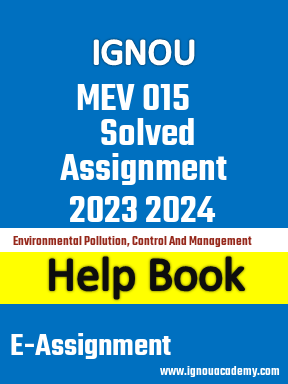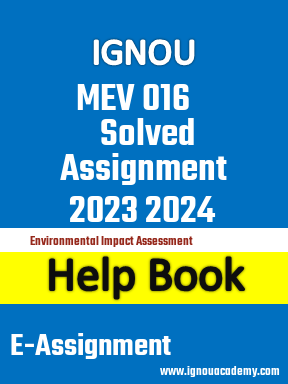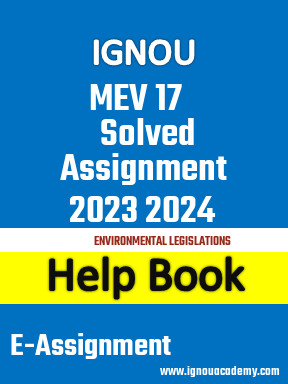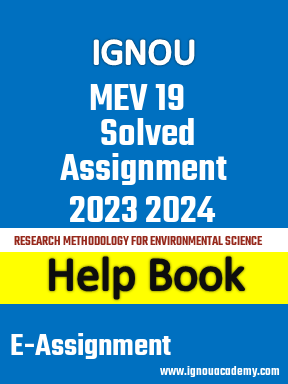My Cart

|
|
IGNOU MSCENV MEV 013 Solved Assignment 2023 2024
IGNOU MSCENV MEV 013 Solved Assignment 2023 2024|
|
| Title Name | IGNOU MSCENV MEV 013 Solved Assignment 2023 2024 |
|---|---|
| Type | Soft Copy (E-Assignment) .pdf |
| University | IGNOU |
| Degree | MASTER DEGREE PROGRAMMES |
| Course Code | MSCENV |
| Course Name | Master of Science (Environmental Science) |
| Subject Code | MEV 013 |
| Subject Name | Environmental Chemistry |
| Year | 2023 2024 |
| Session | - |
| Language | English Medium |
| Assignment Code | MEV-0013/Assignmentt-1//2023-24 |
| Product Description | Assignment of MSCENV (Master of Science (Environmental Science)) 2023-24. Latest MEV 0013 2023-24 Solved Assignment Solutions |
| Last Date of IGNOU Assignment Submission | Last Date of Submission of IGNOU MEV-0013 (MSCENV) 2023-24 Assignment is for January 2023 Session: 30th September, 2023 (for December 2023 Term End Exam). Semester Wise January 2023 Session: 30th March, 2024 (for June 2024 Term End Exam). July 2023 Session: 30th September, 2023 (for December 2023 Term End Exam). |
| Assignment Code | MEV 013/2023 2024 |
|
|
Questions Included in this Help Book
Ques 1.
Explain modern methods of separation and Electrical methods of analysis with suitable examples?
Ques 2.
Accuracy and Precision
Ques 3.
Determinate and Indeterminate Errors
Ques 4.
What are the applications of chromatography technique in environmental monitoring?
Ques 5.
Explain the following with suitable examples
a. Chemical equilibrium & Dynamic equilibrium
b. Aromatic hydrocarbons as environmental pollutants
c. Biochemical effects of Arsenic & Mercury
d. Mechanism of adsorption
Ques 6.
Give a note on scintillation process and working mechanism of scintillation counter?
Ques 7.
Explain the reasons for the following?
a. HF stored in copper bottles and not glass bottles
b. Sodium hypochlorite used as a disinfectant
c. Graphite acts as a lubricant
d. Lead components are added to gasoline and why was it removed with the advent of catalytic convertors
e. TEL was banned as a gasoline additive
Ques 8.
Explain basic instrumentation for IR Spectrometry and its environmental applications?
Ques 9.
a) What is global warming? How is it different from greenhouse effect? What are the environmental outcomes of global warming?
b) Describe the mechanism of ozone formation in the lower troposphere?
Ques 10.
a) What is global warming? How is it different from greenhouse effect? What are the environmental outcomes of global warming?
b) Describe the mechanism of ozone formation in the lower troposphere?
Ques 11.
Explain modern methods of separation and Electrical methods of analysis with suitable examples?
Ques 12.
Accuracy and Precision
Ques 13.
Determinate and Indeterminate Errors
Ques 14.
What are the applications of chromatography technique in environmental monitoring?
Ques 15.
Explain the following with suitable examples
a. Chemical equilibrium & Dynamic equilibrium
b. Aromatic hydrocarbons as environmental pollutants
c. Biochemical effects of Arsenic & Mercury
d. Mechanism of adsorption
Ques 16.
Give a note on scintillation process and working mechanism of scintillation counter?
Ques 17.
Explain the reasons for the following?
a. HF stored in copper bottles and not glass bottles
b. Sodium hypochlorite used as a disinfectant
c. Graphite acts as a lubricant
d. Lead components are added to gasoline and why was it removed with the advent of catalytic convertors
e. TEL was banned as a gasoline additive
Ques 18.
Explain basic instrumentation for IR Spectrometry and its environmental applications?
Ques 19.
What is global warming? How is it different from greenhouse effect? What are the environmental outcomes of global warming?
Ques 20.
Describe the mechanism of ozone formation in the lower troposphere?
Ques 21.
Explain modern methods of separation and Electrical methods of analysis with suitable examples?
Ques 22.
Accuracy and Precision
Ques 23.
Determinate and Indeterminate Errors
Ques 24.
What are the applications of chromatography technique in environmental monitoring?
Ques 25.
Chemical equilibrium & Dynamic equilibrium
Ques 26.
b. Aromatic hydrocarbons as environmental pollutants
Ques 27.
Biochemical effects of Arsenic & Mercury
Ques 28.
Mechanism of adsorption
Ques 29.
Give a note on scintillation process and working mechanism of scintillation counter?
Ques 30.
HF stored in copper bottles and not glass bottles
Ques 31.
Sodium hypochlorite used as a disinfectant
Ques 32.
Graphite acts as a lubricant
Ques 33.
Lead components are added to gasoline and why was it removed with the advent of catalytic convertor
Ques 34.
. TEL was banned as a gasoline additive
Ques 35.
Explain basic instrumentation for IR Spectrometry and its environmental applications?
Ques 36.
What is global warming? How is it different from greenhouse effect? What are the environmental outcomes of global warming?
Ques 37.
Describe the mechanism of ozone formation in the lower troposphere?
Ques 38.
. Explain modern methods of separation and Electrical methods of analysis with suitable examples?
Ques 39.
Accuracy and Precision
Ques 40.
Determinate and Indeterminate Errors
Ques 41.
What are the applications of chromatography technique in environmental monitoring?
Ques 42.
Chemical equilibrium & Dynamic equilibrium
Ques 43.
Aromatic hydrocarbons as environmental pollutants
Ques 44.
Biochemical effects of Arsenic & Mercury
Ques 45.
Mechanism of adsorption
Ques 46.
Give a note on scintillation process and working mechanism of scintillation counter
Ques 47.
HF stored in copper bottles and not glass bottles
Ques 48.
Sodium hypochlorite used as a disinfectant
Ques 49.
Graphite acts as a lubricant
Ques 50.
Lead components are added to gasoline and why was it removed with the advent of catalytic convertors
Ques 51.
TEL was banned as a gasoline additive
Ques 52.
Explain basic instrumentation for IR Spectrometry and its environmental applications?
Ques 53.
a) What is global warming? How is it different from greenhouse effect? What are the environmental outcomes of global warming?
Ques 54.
Describe the mechanism of ozone formation in the lower troposphere?
Ques 55.
Explain modern methods of separation and Electrical methods of analysis with suitable examples?
Ques 56.
Accuracy and Precision
Ques 57.
Determinate and Indeterminate Errors
Ques 58.
What are the applications of chromatography technique in environmental monitoring? 4. Explain the following with
Ques 59.
Chemical equilibrium & Dynamic equilibrium
Ques 60.
. Aromatic hydrocarbons as environmental pollutants
Ques 61.
Biochemical effects of Arsenic & Mercury
Ques 62.
Mechanism of adsorption
Ques 63.
Give a note on scintillation process and working mechanism of scintillation counter?
Ques 64.
HF stored in copper bottles and not glass bottles
Ques 65.
Sodium hypochlorite used as a disinfectant
Ques 66.
Graphite acts as a lubricant
Ques 67.
. Lead components are added to gasoline and why was it removed with the advent of catalytic convertors
Ques 68.
TEL was banned as a gasoline additive
Ques 69.
Explain basic instrumentation for IR Spectrometry and its environmental applications?
Ques 70.
hat is global warming? How is it different from greenhouse effect? What are the environmental outcomes of global warming? b) Describe the mechanism of ozone formation in the lower troposphere?
|
|
Related Assignments
IGNOU Doubts & Queries
Click to Contact Us
Call - 9199852182 Call - 9852900088 myabhasolutions@gmail.com WhatsApp - 9852900088











